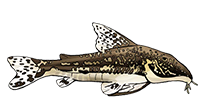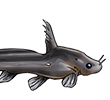In this study, the authors tracked individual catfish and characterized the habitats used by the fish into one of four possible types:ABSTRACT
Knowledge of the movement and habitat use of fishes is important in identifying and understanding the causes of population declines and predicting how populations are likely to respond to management interventions. In this study, radiotelemetry was used to examine the spring and summer movement and habitat use patterns of the freshwater catfish () in a remnant wetland to inform the development of recovery actions for this threatened species. Twenty-one adult fish were tagged and released within Tahbilk Lagoon, Victoria, Australia, in September 2009. Fish were located every 1–2 weeks between September 2009 and February 2010, a period which coincides with the spawning period for the species. Eleven of the fish were also tracked every 2 h for 68 consecutive hours in December 2009 to examine diel movements. The study revealed that freshwater catfish make extensive use of cover (e.g. wood and macrophytes) and typically have limited ranges (median total linear range and 90% linear range 599 and 173 m respectively), although they occasionally moved more extensively (up to 1.5 km) between floodplain and riverine habitats. Fish moved over much greater areas at night compared with during the day. There was also evidence of sex-specific variation in movement, with a trend for greater movement of female fish at night compared with males. The results of the study suggest that strategies that protect macrophyte and wood habitats and improve connectivity between riverine and floodplain habitats are likely to be important in maintaining and restoring remnant populations of this species.
- open water
- wood-only (fallen trees, woody debris, or ‘snags’)
- macrophyte-only (aquatic macrophytes such as native water shield (Brasenia schreberi) and introduced yellow water lily (Nymphaea mexicana)
- mixed wood-macrophyte (woody debris and macrophytes together)
- The catfish typically moved over much greater areas at night compared with during the day.
- At night, females were more active and moved farther than did males. The reduced activity/movement of males at night was presumed to be associated with the natural tendency of the males to stay in one place, guarding egg nests, while the females tend to roam from nest to nest, depositing eggs with multiple males.
- The catfish occupy predominantly shallow (<1 m) littoral (shoreline) habitats, particularly during the day, which is counterintuitive if you expect larger fish to seek deeper water. This may be because these areas contained the highest densities of macrophytes and woody debris.
- Both sexes actively avoided open water at all times of day, using it only rarely.
- Overall, the catfish use mostly mixed wood–macrophyte and macrophyte-only habitats, with mixed wood–macrophyte habitats being most preferable.
- During the day, females and males were both most likely to use mixed wood–macrophyte and wood-only habitats.
- At night, females moved preferentially into macrophyte-only habitats.
- At night, males moved preferentially into wood-only habitats.
Some of this info is summarized in the following table:





